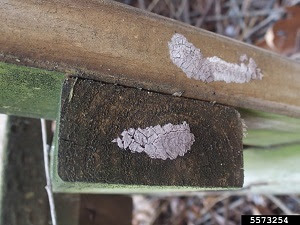For immediate release: June 23 2020
Program contact: Robert Miller, 517-284-5650
Media contact: Jennifer Holton, 517-284-5724
LANSING, Mich. – The Michigan Department of Agriculture and Rural Development (MDARD) is asking the public to be on the lookout for spotted lanternfly, an invasive insect with the potential to seriously affect Michigan’s agriculture and natural resources. This insect could damage or kill more than 70 varieties of crops and plants including grapes, apples, hops and hardwood trees. To date, spotted lanternfly has not been detected in Michigan.
First found in the United States in 2014 in southeastern Pennsylvania, spotted lanternfly has been spreading rapidly across the nation. Infestations have been confirmed in Delaware, Virginia, New Jersey, Maryland and West Virginia.
 “Spotted lanternfly could negatively impact our grape industry,” said Robert Miller, invasive species prevention and response specialist for MDARD. “But it also has the potential to damage stone fruits, apples and other crops in Michigan’s fruit belt as well as important timber species statewide.” “Spotted lanternfly could negatively impact our grape industry,” said Robert Miller, invasive species prevention and response specialist for MDARD. “But it also has the potential to damage stone fruits, apples and other crops in Michigan’s fruit belt as well as important timber species statewide.”
Spotted lanternfly egg masses resemble old chewing gum, with a gray, waxy, putty-like coating. Hatched eggs appear as brownish, seed-like deposits. Spotted lanternfly nymphs are wingless, beetle-like and black with white spots, developing red patches as they mature. Adults are roughly 1 inch long. Their folded wings are gray to brown with black spots. Open wings reveal a yellow and black abdomen and bright red hind wings with black spots transitioning to black and white bands at the edge. |
 “Prevention and early detection are vital to limiting the spread of spotted lanternfly,” said Miller. “Spotted lanternfly cannot fly long distances, but they lay eggs on nearly any surface, including cars, trailers, firewood and outdoor furniture. Before leaving an area where a quarantine is present, check vehicles, firewood and outdoor equipment for unwanted hitchhikers.” “Prevention and early detection are vital to limiting the spread of spotted lanternfly,” said Miller. “Spotted lanternfly cannot fly long distances, but they lay eggs on nearly any surface, including cars, trailers, firewood and outdoor furniture. Before leaving an area where a quarantine is present, check vehicles, firewood and outdoor equipment for unwanted hitchhikers.”
If you find a spotted lanternfly egg mass, nymph or adult, take one or more photos, make note of the date, time and location of the sighting, and report to the Michigan Department of Agriculture and Rural Development, MDA-Info@Michigan.gov or phone the MDARD Customer Service Center, 800-292-3939. If possible, collect a specimen in a container for verification.
For additional information on identifying or reporting spotted lanternfly, visit Michigan.gov/SpottedLanternfly. |
Michigan’s Invasive Species Program is cooperatively implemented by the Department of Environment, Great Lakes, and Energy, the Department of Natural Resources, and the Department of Agriculture & Rural Development.
/Note to editors: Photos are available for download below. Caption information follows.
SLF egg mass: Spotted lanternflies may lay egg masses on vehicles, outdoor furniture or other items that can be transported to new areas, leading to new infestations. Photo courtesy of Emilie Swackhammer, Penn State University, Bugwood.org.
SLF wings: Adult spotted lanterfly’s bright wing coloration is hidden when wings are closed. Photo courtesy of Robert Gardner, Bugwood.org.
SLF adult: Adult spotted lanternflies are identifiable by their bright body and wing colors. Photo courtesy of Pennsylvania Department of Agriculture, Bugwood.org.
SLF life cycle: Spotted lanternflies go through several phases, first resembling spotted beetles before morphing into their adult form. Photo courtesy of Penn State University College of Agricultural Sciences./ |